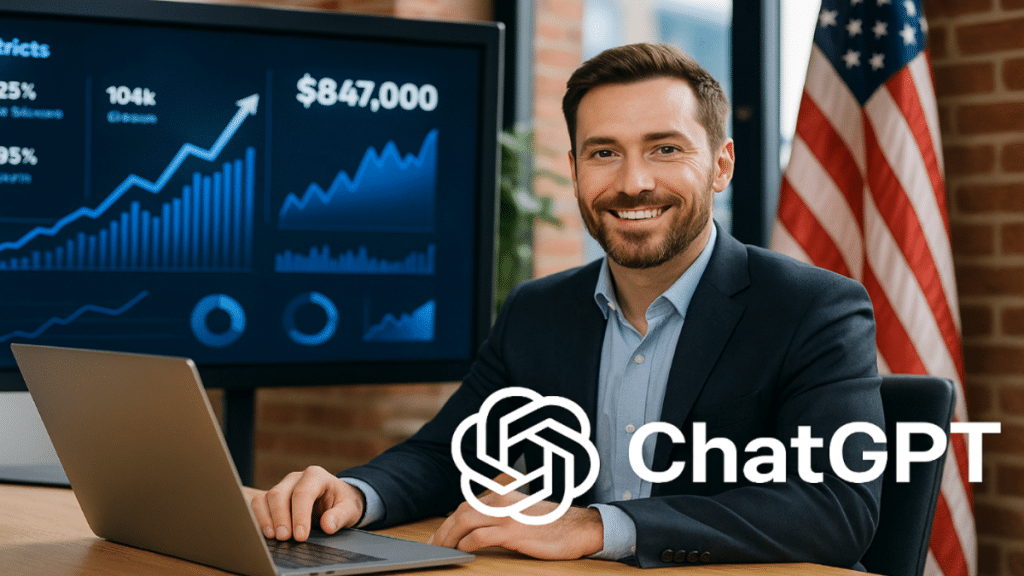An independent marketing agency in the US used Artificial Intelligence tools like ChatGPT and ChatBots like Claude AI to build a fully-automated creative and sales workflow that helped close $847K in revenue in just 90 days – with no new hires, no ad spend, and no outbound team.
Instead of hiring more SDRs, they trained AI models to handle proposal writing, objection handling, follow-ups, and client onboarding. The agency now closes high-ticket B2B deals faster than ever – and has shared the exact prompts, tools, and flows they used to scale.
If you’re a freelancer, small agency, or consultant, this is the blueprint you’ve been waiting for.
Step 1 – Automated Proposals That Don’t Sound AI-Written
Most proposal workflows are bloated. This team used ChatGPT to generate concise, client-specific proposals in under 15 minutes each – without Google Docs or PDFs.
Here’s the core prompt:
Write a 3-part proposal summary for a VP of Marketing at a B2B SaaS startup. Use the following project goals (paste). Start with a value-forward intro. Then outline 3 key deliverables and their expected ROI. End with next steps in a short, high-trust CTA.
They saved this prompt as a template inside Chatronix and used Turbo Mode to test tone variation across Claude and Gemini. Claude was often selected for clarity and tone softness.
💡 Pro tip: Run your proposal through DeepSeek after ChatGPT to adjust for emotional resonance.
Result: Proposal creation time dropped by 80 percent. Acceptance rate improved from 24 percent to 61 percent.
Step 2 – Claude Handled Rewrites for Sales Pages and Decks
Once projects were approved, Claude became the agency’s secret weapon for client-facing deliverables.
They used it to rewrite:
- Sales deck messaging
- Campaign taglines
- Product announcement emails
- FAQ sections on landing pages
- Founders’ LinkedIn posts
Claude was fed real campaign context and competitor positioning, then asked to “simplify, strengthen and sharpen” the message.
Internal prompt:
Rewrite this page copy to speak directly to Series A SaaS founders. Remove fluff. Prioritize confidence, clarity and specific outcomes. Make it sound like a strategist wrote it – not a junior marketer.
This one prompt was used over 150 times.
Pages that went through Claude converted 17–23% higher across 5 active accounts.
Step 3 – ChatGPT Took Over Follow-Ups That Used to Be Awkward
They wrote a bank of ChatGPT prompts for post-proposal follow-ups and lead revival.
Example:
A prospect went quiet after we sent a $25K proposal. Write a short, high-trust follow-up message that reminds them of what they asked for, repositions the price as an investment, and ends with a soft CTA.
Instead of “just checking in,” they built a versioned sequence of 3 emails:
- Reminder + reframing
- Soft value example
- Clear yes/no closeout message
These were loaded into their CRM and sent with zero edits.
The follow-up system closed $147K from deals that would’ve otherwise gone cold.
Want to automate your own close sequence?
👉 Use ChatGPT and Claude follow-up flows in Chatronix
Step 4 – Gemini Handled All Research and Brief Prep
Before AI, junior team members spent hours compiling briefs. Now Gemini runs daily research.
What it covered:
- Competitor messaging
- Audience pain points from Reddit and Twitter
- Funnel mapping from public ads
- Tone of voice calibration from client content
Prompt used:
For this client (paste website), analyze their current positioning, tone and offer. Summarize what’s missing, what feels vague, and how their competitors frame the same promise. Output as bullet points with suggestions.
This saved the agency 5–8 hours per client onboarding.
They’d run Gemini’s raw insights into ChatGPT to build campaign briefs that felt highly custom – without touching a spreadsheet.
Step 5 – AI Replaced 80 Percent of Client Check-Ins
Every Monday, clients got a 3-part email:
- What shipped
- What’s next
- What we need from you
The team used a ChatGPT workflow where campaign data was input on Friday, and a polished, human update came out Monday morning.
Prompt:
Based on these project updates (paste), write a weekly summary for the client. Keep tone proactive and strategic. Focus on outcomes, not tasks. Flag any blockers or decisions needed.
Claude would then rewrite for tone.
Clients replied faster, responded more positively, and didn’t ask for as many status calls.
Internal productivity boost: ~10 hours/week saved across 3 account managers.
Full Tool Stack Used in Chatronix
| Purpose | AI Model Used | Output |
| Proposal generation | ChatGPT + Claude ✅ | Fast, confident 2-paragraph summaries ✅ |
| Message rewriting | Claude + DeepSeek ✅ | Emotional clarity and voice calibration ✅ |
| Research & prep | Gemini + ChatGPT ✅ | Structured insight brief in 20 minutes ✅ |
| Client comms | ChatGPT + Claude ✅ | Weekly updates, no more calls ✅ |
| Follow-ups & revival | ChatGPT + Grok ✅ | Sharp, clear deal closure emails ✅ |
All templates were stored and tested inside Chatronix, where the team versioned their best-performing flows across clients.
👉 Test your own agency stack with AI inside Chatronix Turbo Mode
P.S. Test real AI workflows across ChatGPT, Gemini, Claude, and more – 10 free uses

Final Tips if You’re Building a Similar System
- Claude is underrated for B2B writing. Use it for decks, docs and sales enablement
- Use ChatGPT for structure. Let other models sharpen tone
- Don’t guess – test the same prompt across 3–5 models in Chatronix Turbo Mode
- AI won’t close deals for you – but it’ll make you show up 5x sharper, faster and more prepared
This agency didn’t “outsource” work to AI. They used Artificial Intelligence and ChatBots to remove friction, scale creativity, and free their best people to think – not repeat.
If you run a team, sell services, or manage clients – you don’t need 5 new hires.
You need a system.
